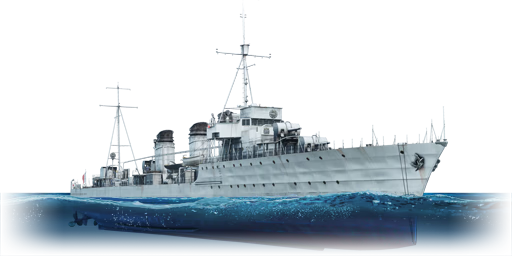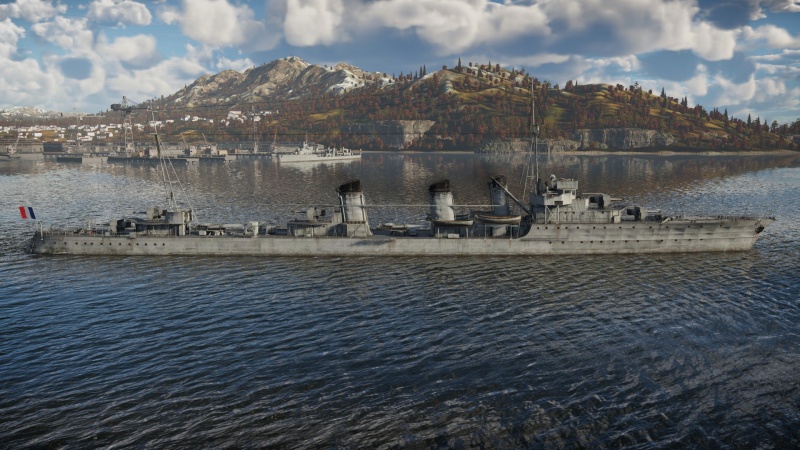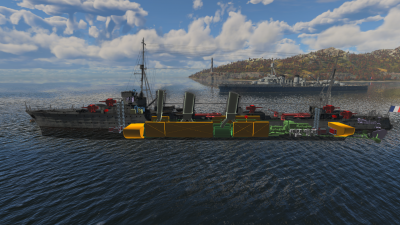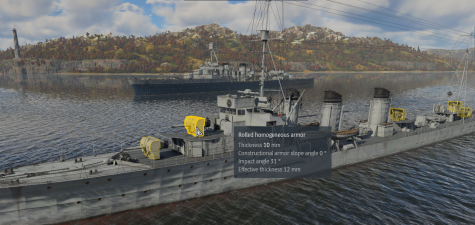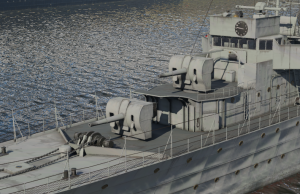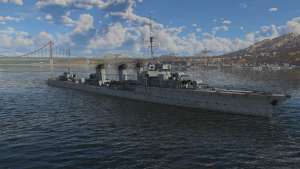Chacal
Contents
Description
The Jaguar-class, Chacal, 1938 is a rank French destroyer with a battle rating of (AB), (RB), and (SB). It was introduced in Update "La Royale".
General info
Survivability and armour
As with most destroyers of this tier, the Chacal lacks any meaningful protection, relying primarily on its mobility for protection. The Chacal has a fairly large crew complement for a ship of its tonnage, granting it a great deal of longevity in combat. The engines and funnels are located in the usual location, amidships, with their only protection being the surrounding fuel tanks. The only armour mounted on the Chacal are the 10 mm thick gun shields mounted on the main guns.
Mobility
The Chacal has a high top speed for its tier, reaching 66 km/h (35.6 kn) when maxed out, allowing it to outrun most ships. The Chacal also has a tight turning circle due to its relatively low tonnage and large rudder, which is further improved with the Rudder Replacement modification.
| Mobility Characteristics | |||
|---|---|---|---|
| Game Mode | Upgrade Status | Maximum Speed (km/h) | |
| Forward | Reverse | ||
| AB | |||
| Upgraded | |||
| RB/SB | |||
| Upgraded | |||
Modifications and economy
As with all naval vessels, Tool Set and Fire Protection System are the top priority. It's personal preference for what modifications to research after these, but it is recommended to research the SAPBC rounds, followed by the mobility upgrades.
Armament
Primary armament
The Chacal features a heavy array of firepower for its size, featuring 5 x 130 mm guns, combining an average rate of fire with extremely deadly ammunition. The firing angles of the forward mounted guns are quite high, however, the two guns in the rear have rather poor angles. The gun mounted amidships has average firing angles. The SAPBC rounds can easily penetrate and destroy modules of enemy destroyers, or at the very least, set the ship on fire. The HE rounds have a high amount of explosive mass, allowing them to easily set a ship on fire, damage deck mounted equipment, disable the rudder of a vessel, and strip the enemy vessel of crew. The main guns have an effective firing distance between 0.5-7 km, any further than that and the shells lose a lot of effectiveness. If a coastal vessel wanders too close, the 130 mm guns will not be able to depress enough to engage it, and the Chacal will have to rely solely on its secondary weapons.
Both ammunition types for the 130 mm guns have a muzzle velocity of 725 m/s, which is subpar compared to contemporary vessels. This makes engagements at longer rangers favour the enemy more, as their rounds travel down range faster. The O.E.A Mle.32 HE rounds have a very high TNT equivalence, sitting at 3.96 kg. The O.P.F.A Mle.23 SAPBC rounds lose 2 kg of TNT equivalence, but gains a significant amount of penetration and a fuse.
| Penetration statistics | |||||||
|---|---|---|---|---|---|---|---|
| Ammunition | Type of warhead |
Penetration @ 0° Angle of Attack (mm) | |||||
| 1,000 m | 2,500 m | 5,000 m | 7,500 m | 10,000 m | 15,000 m | ||
| OEA Mle 1932 | HE | 37 | 37 | 37 | 37 | 37 | 37 |
| OPFA Mle 1923 | SAPBC | 61 | 54 | 43 | 34 | 27 | 25 |
| Shell details | ||||||||||||
|---|---|---|---|---|---|---|---|---|---|---|---|---|
| Ammunition | Type of warhead |
Velocity (m/s) |
Projectile mass (kg) |
Fuse delay (s) |
Fuse sensitivity (mm) |
Explosive mass (TNT equivalent) (kg) |
Ricochet | |||||
| 0% | 50% | 100% | ||||||||||
| OEA Mle 1932 | HE | 725 | 34.83 | 0 | 0.1 | 3.96 | 79° | 80° | 81° | |||
| OPFA Mle 1923 | SAPBC | 725 | 32.05 | 0.035 | 5 | 1.98 | 48° | 63° | 71° | |||
Secondary armament
The Chacal only has two 75 mm guns, providing limited firepower against enemy vessels. They provide no effective anti-aircraft firepower, and due to the low number of guns, make them next to useless when engaging multiple enemies. However, the 75 mm guns are decent at engaging enemy coastal vessels, while allowing them to set the deck of a destroyer on fire, or disable its guns.
The 75 mm guns fire their rounds at 850 m/s, allowing these weapons to easily engage targets at longer ranges. The O.E.A Mle.25 HE round have 450 g of explosive mass, which is more than capable of destroying most coastal vessels in a couple of hits. The O.E.A(FT.) Mle.25 round is a time-fused, having the same explosive mass as the standard HE round. It is not recommended to use this round, as the lack of other secondary weapons necessitates using these guns solely for targeting enemy vessels.
| Penetration statistics | |||||||
|---|---|---|---|---|---|---|---|
| Ammunition | Type of warhead |
Penetration @ 0° Angle of Attack (mm) | |||||
| 100 m | 1,000 m | 2,000 m | 3,000 m | 4,000 m | 5,000 m | ||
| OEA Mle 1925 | HE | 8 | 8 | 8 | 8 | 8 | 8 |
| HE-TF OEA Mle 1925 | HE-TF | 8 | 8 | 8 | 8 | 8 | 8 |
| Shell details | ||||||||||||
|---|---|---|---|---|---|---|---|---|---|---|---|---|
| Ammunition | Type of warhead |
Velocity (m/s) |
Projectile mass (kg) |
Fuse delay (m) |
Fuse sensitivity (mm) |
Explosive mass (TNT equivalent) (g) |
Ricochet | |||||
| 0% | 50% | 100% | ||||||||||
| OEA Mle 1925 | HE | 850 | 5.93 | 0 | 0.1 | 450 | 79° | 80° | 81° | |||
| HE-TF OEA Mle 1925 | HE-TF | 850 | 5.93 | 0 | 0.1 | 450 | 79° | 80° | 81° | |||
Additional armament
The Chacal mounts 2 x triple tube 550 mm torpedo launchers, allowing it to fire a devastating short or long range barrage of torpedoes. The firing angles of the torpedo launchers are quite generous compared to other French destroyers, however, they are sub-par compared to some contemporary vessels. Without the Torpedo Mode modification, the 550 mm torpedoes are devastating at short to medium ranges, as they are fairly mobile torpedoes. With the modification installed, the torpedoes become lethal long range weapons, allowing it to destroy enemy vessels outside of the effective firing range of the main guns. As with other French destroyers, the torpedoes on the Chacal have a large amount of explosive mass compared to most other nations, with the exception of Japanese torpedoes. This allows the Chacal to destroy most vessels it comes across with only 1 or 2 torpedoes.
Usage in battles
In RB, the Chacal is a fast vessel, able to get to good positions fairly quickly, while also allowing it to capture a point early on. This speed allows the Chacal to get out of sticky situations rapidly, however, this can also be a downside for novice captains or those that are unaware, as this mobility can also lead to the vessel being caught in the open, or finding its way into a group of enemy vessels. The mobility of the Chacal is the only form of protection she has, as only the primary weapons have armour, and being hit while sailing the Chacal can be devastating. The ship is quite compact, having all of its engine equipment and fuel tanks close together, allowing them to easily be disabled or set on fire. On the other hand, the magazines of the main guns are very small, making the Chacal almost immune to being ammo racked. The ship also features a lot of empty space in her forward most compartments, meaning glancing blows will do next to nothing to the vessel. What the Chacal lacks in armour, she makes up for with the number of sailors onboard, giving her above average longevity in combat. The large amount of firepower the Chacal brings to bear allows her to go toe-to-toe with all but the strongest of vessels, and what her guns can't destroy, her torpedoes can easily dispatch.
Enemies worth noting:
Enemy vessels that mount guns with a high rate of fire, such as the USS Mitscher, USS Moffett, Spokoinyy, and SKR-7 can easily disable the Chacal and strip it of crew. An easy way to deal with these enemies is to disable their guns and then focus fire on the magazines of their weapons, bringing a swift defeat for these ships.
Light cruisers have enough guns to easily dispatch the Chacal, rapidly stripping away her crew and destroying its vulnerable components. On the other hand, most light cruisers the Chacal can face are fairly light on armour and are usually slow, allowing her SAPBC rounds and torpedoes to easily destroy these vessels, and at the very least, her mobility allowing herself to withdraw to safety.
Pros and cons
Pros:
- 130 mm guns have access to devastating ammunition
- Fast vessel with a tight turning circle, allowing it to get in and out of places quickly and easily dodge torpedoes
- Large crew complement
- Relatively small compared to contemporary destroyers
- Ammunition storage rooms are small, making it hard to ammo rack
- Devastating torpedoes allow her to destroy any enemy encountered
Cons:
- 75 mm guns provide inadequate anti-aircraft firepower
- Limited firing angles with rear mounted guns
- Engines and fuel tanks are close together, making them easy to hit
- Ships whose guns have high rates of fire can easily destroy the Chacal
History
The Chacal-class ships were born out of a 1922 requirement for a large destroyer, and was the first of a series of large destroyers for the Marine Nationale. The Chacal was the lead ship of her class, and was laid down in 1923, and after construction delays, was finally completed in 1926, entering service the same year. The Chacal was assigned to the Mediterranean Squadron, where she spent the next decade as a training ship. Following the outbreak of the war, she was assigned to convoy escort in the Atlantic, until the Battle of France saw her stationed in the English Channel. In 1940, the Chacal was refitted with the Type 123 sonar and had two of her depth charge throwers reinstalled. On the night of 23/24 of May, 1940, she was crippled by German artillery and aircraft, and consequently beached herself near Boulogne-sur-Mer as a result of the damage. The wreckage was never recovered, and can still be seen to this day.
Media
Excellent additions to the article would be video guides, screenshots from the game, and photos.
See also
- Similar ships from other nations
External links
| France destroyers | |
|---|---|
| Bourrasque-class | Bourrasque · Tornade |
| Chacal-class | Chacal · Leopard · Panthere |
| Aigle-class | Aigle · Vautour · Milan |
| Vauquelin-class | Vauquelin |
| Le Fantasque-class | Le Malin · Le Triomphant |
| Mogador-class | Mogador |
| Hunt-class | La Combattante |
| Trophies | Germany |
| Desaix-class¹ | Kleber |
| Type 1936 | Marceau |
| Italy | |
| Chateaurenault-class² | Guichen |
| Modified: ¹Type 1934A-class destroyers · ²Capitani Romani-class cruisers | |


